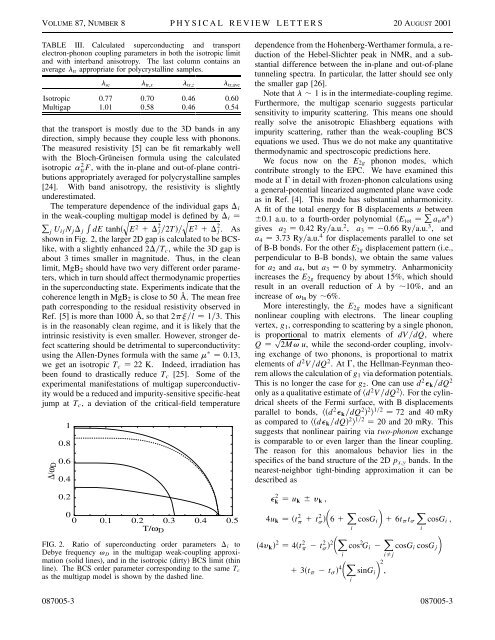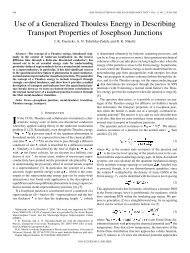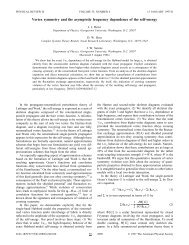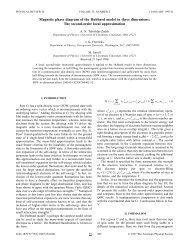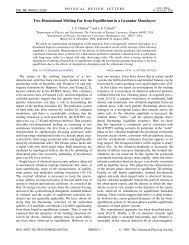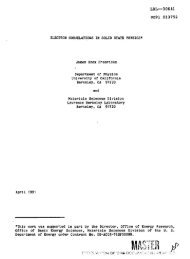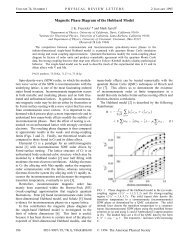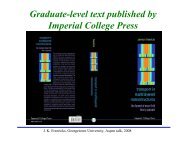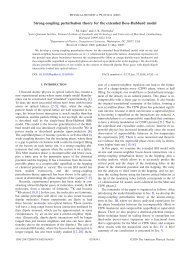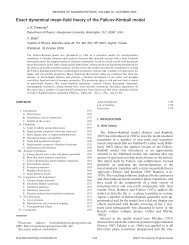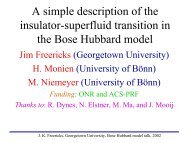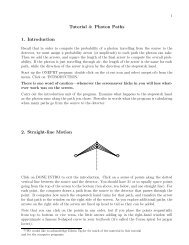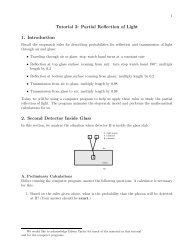Beyond Eliashberg superconductivity in MgB2 - Physics ...
Beyond Eliashberg superconductivity in MgB2 - Physics ...
Beyond Eliashberg superconductivity in MgB2 - Physics ...
Create successful ePaper yourself
Turn your PDF publications into a flip-book with our unique Google optimized e-Paper software.
VOLUME 87, NUMBER 8 PHYSICAL REVIEW LETTERS 20AUGUST 2001<br />
TABLE III. Calculated superconduct<strong>in</strong>g and transport<br />
electron-phonon coupl<strong>in</strong>g parameters <strong>in</strong> both the isotropic limit<br />
and with <strong>in</strong>terband anisotropy. The last column conta<strong>in</strong>s an<br />
average l tr appropriate for polycrystall<strong>in</strong>e samples.<br />
l sc l tr,x l tr,z l tr,ave<br />
Isotropic 0.77 0.70 0.46 0.60<br />
Multigap 1.01 0.58 0.46 0.54<br />
that the transport is mostly due to the 3D bands <strong>in</strong> any<br />
direction, simply because they couple less with phonons.<br />
The measured resistivity [5] can be fit remarkably well<br />
with the Bloch-Grüneisen formula us<strong>in</strong>g the calculated<br />
isotropic atr 2 F, with the <strong>in</strong>-plane and out-of-plane contributions<br />
appropriately averaged for polycrystall<strong>in</strong>e samples<br />
[24]. With band anisotropy, the resistivity is slightly<br />
underestimated.<br />
The temperature dependence of the <strong>in</strong>dividual gaps D i<br />
<strong>in</strong> the weak-coupl<strong>in</strong>g multigap model is def<strong>in</strong>ed by D i <br />
R q<br />
q<br />
Pj U ij N j D j dE tanh E 2 1Dj2T<br />
2 E 2 1Dj.<br />
2 As<br />
shown <strong>in</strong> Fig. 2, the larger 2D gap is calculated to be BCSlike,<br />
with a slightly enhanced 2DT c , while the 3D gap is<br />
about 3 times smaller <strong>in</strong> magnitude. Thus, <strong>in</strong> the clean<br />
limit, MgB 2 should have two very different order parameters,<br />
which <strong>in</strong> turn should affect thermodynamic properties<br />
<strong>in</strong> the superconduct<strong>in</strong>g state. Experiments <strong>in</strong>dicate that the<br />
coherence length <strong>in</strong> MgB 2 is close to 50 Å. The mean free<br />
path correspond<strong>in</strong>g to the residual resistivity observed <strong>in</strong><br />
Ref. [5] is more than 1000 Å, so that 2pjl 13. This<br />
is <strong>in</strong> the reasonably clean regime, and it is likely that the<br />
<strong>in</strong>tr<strong>in</strong>sic resistivity is even smaller. However, stronger defect<br />
scatter<strong>in</strong>g should be detrimental to <strong>superconductivity</strong>:<br />
us<strong>in</strong>g the Allen-Dynes formula with the same m 0.13,<br />
we get an isotropic T c 22 K. Indeed, irradiation has<br />
been found to drastically reduce T c [25]. Some of the<br />
experimental manifestations of multigap <strong>superconductivity</strong><br />
would be a reduced and impurity-sensitive specific-heat<br />
jump at T c , a deviation of the critical-field temperature<br />
∆/ωD<br />
1<br />
0.8<br />
0.6<br />
0.4<br />
0.2<br />
0<br />
0 0.1 0.2 0.3 0.4 0.5<br />
T/ω D<br />
FIG. 2. Ratio of superconduct<strong>in</strong>g order parameters D i to<br />
Debye frequency v D <strong>in</strong> the multigap weak-coupl<strong>in</strong>g approximation<br />
(solid l<strong>in</strong>es), and <strong>in</strong> the isotropic (dirty) BCS limit (th<strong>in</strong><br />
l<strong>in</strong>e). The BCS order parameter correspond<strong>in</strong>g to the same T c<br />
as the multigap model is shown by the dashed l<strong>in</strong>e.<br />
dependence from the Hohenberg-Werthamer formula, a reduction<br />
of the Hebel-Slichter peak <strong>in</strong> NMR, and a substantial<br />
difference between the <strong>in</strong>-plane and out-of-plane<br />
tunnel<strong>in</strong>g spectra. In particular, the latter should see only<br />
the smaller gap [26].<br />
Note that l 1 is <strong>in</strong> the <strong>in</strong>termediate-coupl<strong>in</strong>g regime.<br />
Furthermore, the multigap scenario suggests particular<br />
sensitivity to impurity scatter<strong>in</strong>g. This means one should<br />
really solve the anisotropic <strong>Eliashberg</strong> equations with<br />
impurity scatter<strong>in</strong>g, rather than the weak-coupl<strong>in</strong>g BCS<br />
equations we used. Thus we do not make any quantitative<br />
thermodynamic and spectroscopic predictions here.<br />
We focus now on the E 2g phonon modes, which<br />
contribute strongly to the EPC. We have exam<strong>in</strong>ed this<br />
mode at G <strong>in</strong> detail with frozen-phonon calculations us<strong>in</strong>g<br />
a general-potential l<strong>in</strong>earized augmented plane wave code<br />
as <strong>in</strong> Ref. [4]. This mode has substantial anharmonicity.<br />
A fit of the total energy for B displacements u between<br />
60.1 a.u. to a fourth-order polynomial E tot P a n u n <br />
gives a 2 0.42 Rya.u. 2 , a 3 20.66 Rya.u. 3 , and<br />
a 4 3.73 Rya.u. 4 for displacements parallel to one set<br />
of B-B bonds. For the other E 2g displacement pattern (i.e.,<br />
perpendicular to B-B bonds), we obta<strong>in</strong> the same values<br />
for a 2 and a 4 ,buta 3 0 by symmetry. Anharmonicity<br />
<strong>in</strong>creases the E 2g frequency by about 15%, which should<br />
result <strong>in</strong> an overall reduction of l by 10%, and an<br />
<strong>in</strong>crease of v ln by 6%.<br />
More <strong>in</strong>terest<strong>in</strong>gly, the E 2g modes have a significant<br />
nonl<strong>in</strong>ear coupl<strong>in</strong>g with electrons. The l<strong>in</strong>ear coupl<strong>in</strong>g<br />
vertex, g 1 , correspond<strong>in</strong>g to scatter<strong>in</strong>g by a s<strong>in</strong>gle phonon,<br />
is proportional to matrix elements of dVdQ, where<br />
Q p 2Mv u, while the second-order coupl<strong>in</strong>g, <strong>in</strong>volv<strong>in</strong>g<br />
exchange of two phonons, is proportional to matrix<br />
elements of d 2 VdQ 2 .AtG, the Hellman-Feynman theorem<br />
allows the calculation of g 1 via deformation potentials.<br />
This is no longer the case for g 2 . One can use d 2 e k dQ 2<br />
only as a qualitative estimate of d 2 VdQ 2 . For the cyl<strong>in</strong>drical<br />
sheets of the Fermi surface, with B displacements<br />
parallel to bonds, d 2 e k dQ 2 2 12 72 and 40 mRy<br />
as compared to de k dQ 2 12 20 and 20 mRy. This<br />
suggests that nonl<strong>in</strong>ear pair<strong>in</strong>g via two-phonon exchange<br />
is comparable to or even larger than the l<strong>in</strong>ear coupl<strong>in</strong>g.<br />
The reason for this anomalous behavior lies <strong>in</strong> the<br />
specifics of the band structure of the 2D p x,y bands. In the<br />
nearest-neighbor tight-b<strong>in</strong>d<strong>in</strong>g approximation it can be<br />
described as<br />
e 2 k u k 6y k ,<br />
4u k t 2 p 1 t2 s µ<br />
6 1 X i<br />
4y k 2 4t 2 p 2 t2 s 2 µ X<br />
i<br />
1 3t p 2 t s 4 µ X<br />
i<br />
∂<br />
X<br />
cosG i 1 6t p t s cosG i ,<br />
cos 2 G i 2 X ∂<br />
cosG i cosG j<br />
ifij<br />
s<strong>in</strong>G i<br />
∂ 2<br />
,<br />
i<br />
087005-3 087005-3


